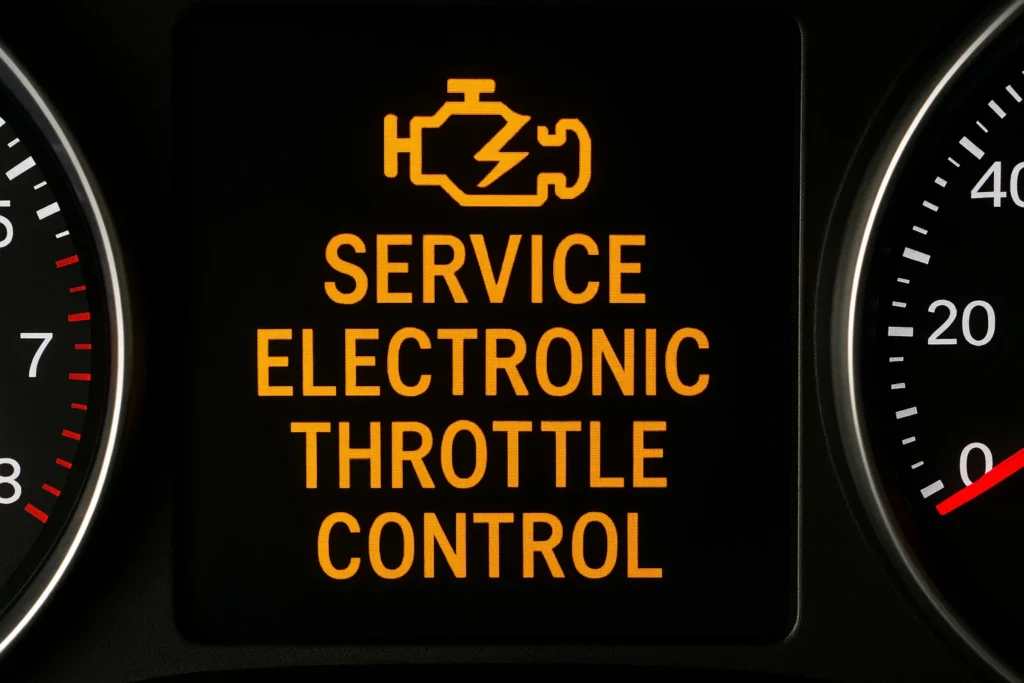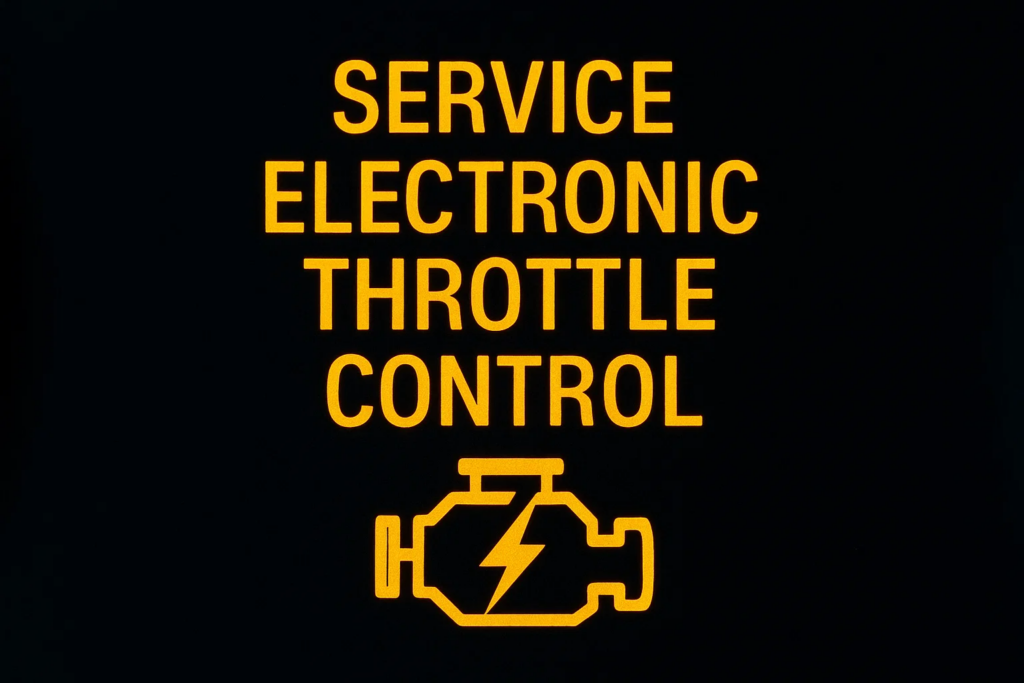
service electronic throttle control
Ever been cruising down the highway when—bam!—your dashboard lights up like a Christmas tree, and you see this mysterious message: Service Electronic Throttle Control?
Yeah, that one. It’s enough to make anyone clench the steering wheel a little tighter. service electronic throttle control
Don’t panic just yet. Let’s break it down, like you’re sitting with your favorite car-nerd friend explaining it over a cup of coffee (or an energy drink if you’re on the go). I’m going to walk you through what the electronic throttle control (ETC) system does, what that warning light means, what causes it, and most importantly—what you should do next. service electronic throttle control
What Is the Electronic Throttle Control System Anyway?

Once upon a time (okay, in the ’90s and earlier), your gas pedal was connected to your engine by a cable. Press pedal → cable pulls → throttle opens. It was mechanical. Simple. Pretty reliable.
Today’s cars are smarter—and more electronic.
In modern vehicles, the gas pedal isn’t physically connected to the engine. Instead, it’s wired to a sensor. When you step on the pedal, a signal is sent to your car’s computer (the ECU), which then tells an electric motor to open the throttle plate.
This is what we call “drive-by-wire.”
And the system that makes all that happen? That’s your Electronic Throttle Control (ETC) system. service electronic throttle control
Why do manufacturers use ETC?
Because it’s:
- More fuel-efficient
- Quicker to respond to driving conditions
- Better for emissions
- Capable of working with modern features like cruise control, traction control, and even self-driving tech
So yeah, it’s a good thing—when it works.
So What Does “Service Electronic Throttle Control” Actually Mean?
Short version: Your car’s computer has detected something wrong in the throttle system.
When that “Service Electronic Throttle Control” warning pops up on your dashboard, it’s your car telling you:
“Hey, something’s wrong with the way I’m controlling your throttle, and you should probably check it out.”
This could be a glitch, a faulty sensor, wiring issues, or a component beginning to fail.
And here’s the kicker: Your car might go into “limp mode.”
This means your car limits its speed and acceleration to prevent further damage. It’s like your car is grounding itself until it gets fixed. service electronic throttle control
Common Symptoms of ETC Problems
Besides that ominous dashboard warning, here are a few things you might notice if your throttle control is acting up: service electronic throttle control
- Rough idling
- Poor acceleration
- Stalling
- Unresponsive gas pedal
- Check engine light (yep, sometimes both show up)
- Surging or jerking when driving
In short: If it feels like your car suddenly forgot how to be a car, this could be why. service electronic throttle control
What Causes the Electronic Throttle Control Light to Come On?
Ah yes, the million-dollar question. There are a few usual suspects here: service electronic throttle control
1. Faulty Throttle Position Sensor (TPS)
This sensor tells your engine how much you want to accelerate. If it fails, your engine doesn’t know what to do. service electronic throttle control
2. Bad Accelerator Pedal Position Sensor (APP)
This one’s attached to your pedal. If it sends the wrong signal, the ECU gets confused. service electronic throttle control
3. Wiring Issues
Damaged, frayed, or disconnected wiring between sensors and the ECU can cause miscommunication. service electronic throttle control
4. Throttle Body Issues
The throttle body itself (with its motor and plate) can wear out or get dirty over time, affecting how smoothly it opens and closes. service electronic throttle control
5. Software Glitches
Sometimes it’s just a software hiccup that can be reset with a scan tool or a battery disconnect (more on that soon). service electronic throttle control
How to Fix Electronic Throttle Control Problems
Okay, so your car is throwing a fit. Now what?
Step 1: Pull Over Safely
If the warning just popped up and your car starts acting weird, pull over. Better safe than sorry—especially if it’s gone into limp mode. service electronic throttle control
Step 2: Restart Your Car
Sometimes the issue is temporary. Turn the car off, wait a minute, and start it again. If it was a glitch, the light might disappear.
Step 3: Check for Error Codes
Use an OBD-II scanner to check for diagnostic trouble codes (DTCs). Even if you’re not a mechanic, these codes can point you in the right direction. Most auto parts stores will scan it for free.
Step 4: Inspect the Throttle Body
If you’re comfortable opening the hood, take a look at the throttle body. A buildup of carbon can cause sticking—cleaning it with throttle body cleaner can help.
Step 5: Visit a Mechanic
If DIY isn’t your style—or if the issue persists—it’s time to see a pro. They’ll run full diagnostics and test the sensors and wiring.
Can I Drive With the Electronic Throttle Control Light On?
Technically, yes. But should you? Probably not for long.
If your car is in limp mode, you’re stuck going slow—like turtle-on-a-hike slow. It’s frustrating, unsafe in traffic, and can make existing issues worse. Even if the car seems okay, you’re rolling the dice by ignoring it.
So yes, you might make it home or to the shop, but don’t treat it like a long-term solution.
How Much Does It Cost to Fix?
Let’s talk numbers.
| Repair | Estimated Cost (USD) |
|---|---|
| Throttle body cleaning | $50–$100 |
| New throttle body | $300–$700 |
| TPS or APP sensor replacement | $100–$300 |
| Wiring repairs | $100–$500 |
| Labor (if going to a shop) | $100–$200/hour |
DIY can save you money, especially if it’s just cleaning the throttle body or resetting the ECU. But if it’s a deeper issue? Worth letting the pros handle it.
How to Prevent ETC Problems in the Future
You can’t prevent everything, but here’s how to keep that system happy:
- Clean the throttle body every 30,000–50,000 miles
- Don’t ignore check engine lights—they’re often early warning signs
- Avoid flooding your engine or jump-starting incorrectly
- Use quality fuel to reduce carbon buildup
- Keep up with regular maintenance
Final Thoughts: Don’t Ignore That Light
Look, nobody wants to see the “Service Electronic Throttle Control” light mid-commute. But ignoring it can lead to stalling, poor fuel economy, and even complete breakdowns.
The ETC system is small but mighty.
It’s not just about going faster—it’s about your car responding the way it should. When it’s out of whack, your ride turns into a drama queen real quick.
So whether you’re a seasoned DIYer or someone who only opens the hood to top off washer fluid, the best move is act fast, don’t panic, and get the problem diagnosed. Your car (and your wallet) will thank you.
Have You Had ETC Issues?
Ever had that light pop up at the worst possible time? Got a funny or frustrating story about limp mode? Drop it in the comments or share your fix—it might help someone else out there!




